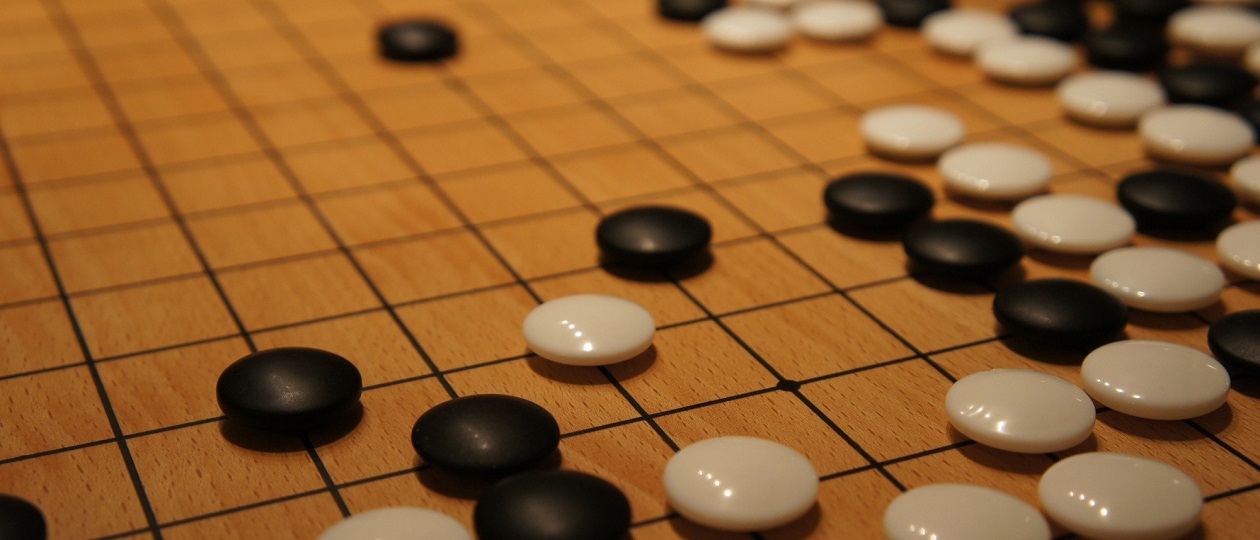
Today, in the era of synergetics, the theory of complex systems, controlled chaos, the second advent of the Go game, born more than 4000 years ago, took place. The Pentagon began studying Go from the time of World War II. Japanese and Korean corporations today create strategic management departments, in which the masters of this ancient game work.
Go is different from intellectual (logical) games. Chess and checkers is a model of battle: victory means winning. During the Go game, several dozen fights can take place on the board, but even if you win all of them, you can lose the game. In Go, winning is determined by scoring at the end of the game. In chess and checkers, the priority is a logical analysis of the options; the player, like a playwright, thinks in stories. In Go, the master thinks in forms, images, like a sculptor or artist, logic works at critical moments.
Go is not a model of war, it is a model of a World consisting of two states. In the game, partners through peaceful coexistence, development, conflicts and brutal wars strive to achieve harmony, in this case, the games of professionals end with a margin of half a point (in Go, a draw is almost impossible).
The essence of the game is simple: Alternately putting stones on an empty board, partners fence off part of this “emptiness” with a stone fence, trying to occupy a larger space. Accordingly, blacks and whites build their own states. At the rule level, this seems easier than building a chicken coop. However …
Having captured a gigantic territory, the player suddenly sees that his position is collapsing, some groups of stones are dying and having difficulty, he is transferred to the opponent. In Go, stones can die if cut off from living space. They “choke” and die with a lack of “emptiness”. However, retaining all the stones completely, you lose due to the smallness of the territory. Go is the mastery of a balance of absolute contradictions.
As a rule, one of the players plays on a qualitative advantage, the other seeks to obtain a quantitative advantage in the territory. During the game, quantity and quality periodically pass into each other. Such transitions are carried out in leaps through tactical combinations called tesuji. There are no more combinations in Go than in chess. As a result of tesuji, the situation on the board can change dramatically. The hunter will become a prey, the winner will be defeated.
The game can be won only by combining many factors into a complex system, some of which lie beyond the limits of human perception and are not amenable to logical analysis. It seems unbelievable.
However, such “incredible” is commonplace in human life. A gardener who does not know genetics and biology, using a hoe and a watering can, creates a complex system called “Beautiful Garden”. It is impossible to make a fragrant apple by acting directly on some raw material, however, you can harvest a rich crop by indirectly acting through the plant and soil.
Go’s game is the art of cultivation. Direct actions are doomed to failure. If you attack a direct group of stones, we most likely will not be able to kill it, taking a course on the direct construction of strong, protected territories, very soon we will lose development prospects and lose.
Go is an indirect action strategy. They attack the opponent’s stones, not in order to kill them, but in order to gain territory away from the clash. The opponent’s stones are alive, and the player received a decisive advantage. Or they fight with stones in the corner to kill the group in the center of the board. To attack, they build territory, to gain strength — they attack.
At first glance, Go’s party resembles the interweaving of fighting dragons: black and white stones cover the board with a fancy pattern. This seems like chaos that is impossible to figure out. Each of the groups of stones has a lot of potentialities, and having realized one of them, you give the opponent all the others to choose from. Having defended one weak group, you give the other to be torn to pieces. The bottom line is to exchange a brick for jasper, and there is no guarantee that your jasper will not turn into a brick.
Clausewitz writes in his book “On War”: “Strategy is the art of using battles for war purposes.” You can perfectly understand each local situation in different areas of the board and make profitable exchanges, get many advantages through indirect actions, but not achieve victory. Victory can be achieved only by subordinating the single goal of all your victories and defeats, gains and losses.
Strategy is the art of creating circumstances. Stones, unlike chess pieces, have low combat power. A chess piece can take any piece or pawn, however, attacking a lone Go stone on an empty board, it is impossible to take it, he will always be able to escape. Only after creating the circumstances we need will we endow our stones with power, and weaken the enemy’s stones, and only then will it become possible to win in future tactical battles. Go’s essence is strategy.
A pile of gears, even from gold and platinum, is chaotic and dead, an ordinary tin alarm clock assembled from primitive details, in contrast to it, has a complex structure and functions. The game of Go fosters in a person the ability to integrate thinking, the unification of multidirectional forces and factors into a single complex system. Go is a systematic analysis from antiquity.
Go is a model of our world in which evolution and catastrophes and revolutions are present. Go is a wonderful illustration of Hegelian dialectics, the theory of controlled chaos, the concept of “effects-based operations”, even terrorism is modeled in the game, this is the so-called “Ko fight” (Kou-arasoi). But most importantly, Go is a model of the world as a way of coexistence, a model of development with unity and the struggle of contradictions, it is a model of Harmony burning and reborn like a Phoenix. This is the world of Complexity.
In a world in a state of unstable equilibrium, crisis phenomena develop. Many political science concepts and military theories make sense of this. But the theory explains, but in practice it turns out that thousands of factors work and changing one of them, according to the theory, does not lead to the desired result.
Go is not a theory, this is a model practice of working with Complexity, and like any practice, it develops skills and hones mastery. Go is an excellent tool for educating modern strategic leaders, developing the will and ability of holistic and paradoxical thinking, a simulator for “bloodless” development of skills for changing circumstances and development in a crisis.





